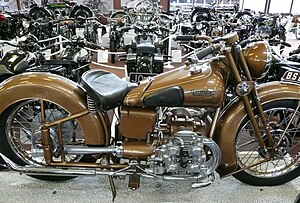Brough Superior Dream
| Brough Superior | |
|---|---|
 Brough Superior Golden Dream (1938) |
|
| Manufacturer | Brough Superior |
| Production period | from 1938 |
| class | motorcycle |
| design type | classic |
| Motor data | |
| Four-stroke engine , air-cooled four-cylinder H-engine , OHV valve control , dry sump lubrication ; two Amal carburettors, magneto ignition (Magdyno) from Lucas | |
| Displacement (cm³) | 987 (prototype) 996 (Golden Dream) |
| transmission | 3-speed with foot control 4-speed in development |
| drive | Cardan |
| Brakes | front and rear: drum brake |
| Wheelbase (mm) | 1473 |
| Previous model | Brough Superior SS100 |
The Brough Superior Dream was a motorcycle from the British manufacturer Brough Superior , of which two copies were built. When it was presented in November 1938, George Brough claimed that the Brough Superior Dream would be the best production motorcycle in the world. In addition to the prototype with a black painted frame and chrome-plated tank and exhaust, there was a gold-colored version that went down in history as the “Golden Dream”. The golden color was used here for the first time on a motorcycle.
History and technology
The previous model, the Brough Superior SS100 , was already one of the fastest motorcycles of that time. But the smoothness of the V2 engine was not enough for Broughs' requirements, so a four-cylinder engine with smooth running should power his dream motorcycle. Instead of an in-line engine, an H engine was installed in a motorcycle for the first time and so far only . In principle, it consisted of two air-cooled 180 ° V-engines , which were arranged one above the other. The crankshafts were connected by a pair of gears and rotated in opposite directions, which resulted in very smooth engine running. The cylinders were in one plane, so a connecting rod was forked on each crankshaft. Rotating counterweights on the crankshafts created a perfect mass balance. The common housing of the engine and gearbox was divided vertically. Two chain-driven camshafts below controlled the valves via mushroom tappets , bumpers and rocker arms . This engine construction originally came from the aviation pioneer Capt. John Palethorpe. The engine of the prototype, known as Langhuber (bore / stroke: 68 mm), did not achieve the approval of George Brough with regard to its smoothness. Harry Hatch, formerly a designer at Blackburne , and Freddie Dixon therefore developed a short stroke (bore / stroke: 71 × 63 mm) for Brough that achieved the required smoothness. The engine installed lengthways gave its power to the rear wheel via a clutch, a three-speed foot-operated gearbox and an encapsulated cardan shaft with a worm drive.
The chassis of the Brough Superior Dream consisted of a double tube frame, the 19-inch front wheel was guided in a pushed short swing arm with an auxiliary fork (Castle fork) patented by Brough , and the 19-inch rear wheel was sprung with straight-line suspension. The motorcycle was not tested until it was presented at the Earls Court Exhibition Center . The performance of the engine was disappointing, more than 80 miles per hour (≈ 128 km / h) was not possible. Test driver Stevenson drove about 7,000 miles before a broken tappet ended the trip. It was suspected that the Brough Superior Dream was just a show bike, the series production of which was never planned due to the lack of reliability.
The development of the motorcycle was not yet complete when World War II broke out. Both examples have been preserved: the prototype in Albert Wallis' inventory and the Brough Superior Golden Dream, which is in the National Motorcycle Museum in Birmingham . While the price of a Brough Superior SS100 is quoted at up to 500,000 euros, the Brough Superior Dream ( offered for £ 185 in 1938 ) is now considered priceless.
literature
- Roy Bacon: Encyclopedia of British Motorcycles from The 1930s. Promotional Reprint, 1995. ISBN 1-8564-8300-2 .
- Roger Hicks: The Encyclopedia of Motorcycles. Amber Books, 2003. ISBN 3-613-02660-0 .
- Peter Miller: Brough Superior. The Complete Story. The Crowood Press, Ramsbury 2010. ISBN 978-1-84797-112-8 .
- Hugo Wilson: The Lexicon of the Motorcycle . Motorbuch Verlag, Stuttgart 2001. ISBN 3-613-01719-9 .
Web links
References and comments
- ↑ broughsuperiorclub.com ( Memento of the original from March 14, 2016 in the Internet Archive ) Info: The archive link was inserted automatically and has not yet been checked. Please check the original and archive link according to the instructions and then remove this notice. Models (as of March 6, 2017)
- ↑ Peter Miller: Appendix V.
- ↑ Peter Miller: p. 165.
- ↑ Brough Superior Dream ( Memento of the original from March 9, 2016 in the Internet Archive ) Info: The archive link was inserted automatically and has not yet been checked. Please check the original and archive link according to the instructions and then remove this notice.
- ^ Roy Bacon: p. 64.
- ↑ See Peter Miller: p. 167
- ^ Hugo Wilson: p. 35.
- ↑ a b François-Marie Dumas: moto-collection.org (as of April 14, 217)
- ^ Roy Bacon: p. 36.
- ↑ bmwdean.com ( Memento of the original from August 8, 2015 in the Internet Archive ) Info: The archive link was inserted automatically and has not yet been checked. Please check the original and archive link according to the instructions and then remove this notice. The Dream could be supplied with 3- or 4-speed transmission, and the final drive is by silent, underslung worm .
- ↑ Peter Miller: p. 167.
- ↑ See Roger Hicks: p. 97.
- ↑ Oldtimer Markt : Motorrad-Spezial No. 9, 2017, p. 32.

